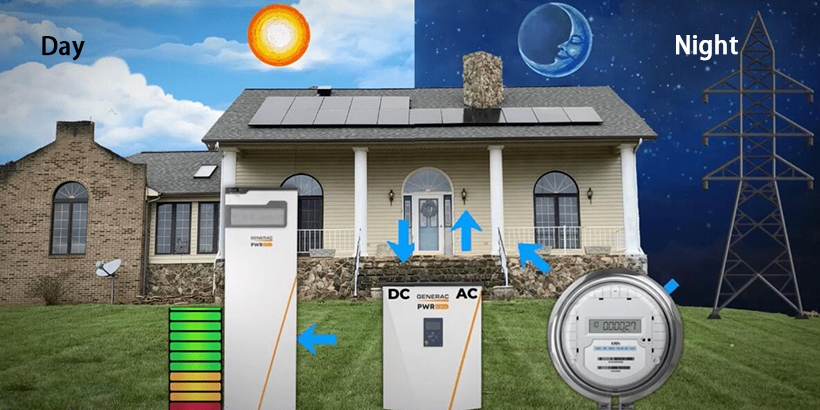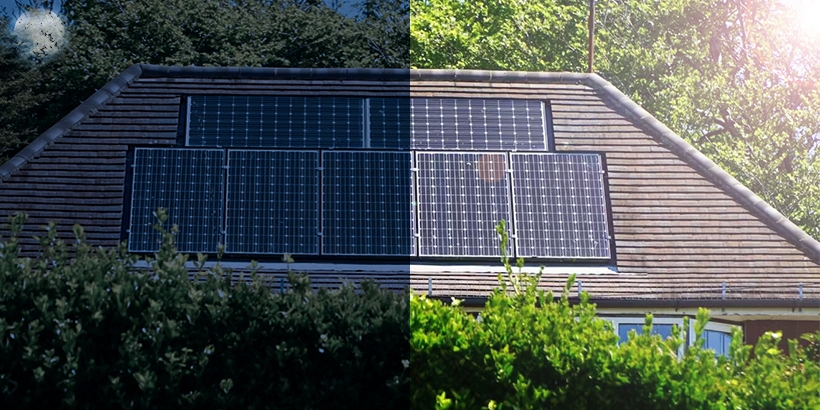Did you know that your solar system is working at all hours of the day? Although solar energy is generated when the sun is out, that energy can also be used during the night thanks to a backup battery system. If you’re a current owner of solar panels, or are thinking about going solar, it’s important to understand how your solar system works during the daytime and nighttime cycles. Additionally, understanding the benefits of solar batteries and how they bring additional value to your home by storing energy for later use is important. The following is the entire solar activity process of the day/night cycle as summarized by Off the Grid for Your Home.

To further understand what happens day and night, let's break it down by each cycle.
The Day Cycle
Solar power systems primarily consist of solar panels, an inverter, and sometimes a battery storage system. The solar panels are installed on your roof or another sunny location, where they convert sunlight into direct current (DC) electricity. This DC electricity is then sent to the inverter, which converts it into alternating current (AC) electricity, the type used by most household appliances.
If your panels collect more than enough energy for your home, the excess energy is then sent to your battery system for storage. This excess energy can be used overnight when the sun isn’t shining, or it can be used in the event of a power outage.
Powerhome’s systems are all grid-tied which serves as an advantage for homeowners if the utility companies offer net metering. Net metering occurs when your system produces more solar energy than your home needs at any given time. The excess energy is sent to the power grid for a potential credit on your electric bill.
Homes with grid-tied solar power systems can benefit from net metering. Net metering allows homeowners to send excess solar energy back to the grid in exchange for credits on their utility bills. During the night or cloudy periods, when sun panels are not generating enough electricity, you can use these credits to draw power from the grid. This system provides a financial benefit and ensures you always have a reliable power source.
The Night Cycle
Once the sun goes down, the grid and your battery can work together to meet the needs of your home. Note that your battery will power only pre-chosen loads within your home such as your refrigerator, microwave, sump pump or home office equipment.
Outside of being a storage container for energy, battery system helps combat the negative effects of power outages in the event of harsh weather and it also helps counter time-of-use rates. Backup battery system has four separate modes tailored to your needs and helps future-proof your home.

Advantages of a Solar Power System
- Reduced Electricity Bills: By generating your own electricity, you can significantly reduce or even eliminate your monthly utility bills.
- Energy Independence: Solar power systems, especially those with battery storage, provide energy independence, reducing reliance on the grid.
- Environmental Benefits: Solar power is a clean, renewable energy source that reduces your carbon footprint and helps combat climate change.
- Increased Property Value: Homes equipped with solar power systems often have higher property values and are more attractive to buyers.
Choosing the Right Solar System
When considering a solar power system for your home, it's essential to work with a reputable installer who can design a system tailored to your energy needs and location. Factors like your roof's orientation, shading, and local climate will influence the system's performance. Additionally, consider investing in a battery storage solution to maximize the benefits of your solar power system.
The basic principle of solar energy operation is to harness the energy from solar radiation to generate electricity or heat. In a photovoltaic (PV) system, solar panels are crucial components typically installed on rooftops or in locations with ample sunlight. These panels consist of numerous photovoltaic cells made from semiconductor materials, often silicon, which absorb photons from sunlight. The energy from these photons causes electrons to be released from the semiconductor material, generating direct current (DC) electricity.
This DC electricity is then transmitted to an inverter, which converts it into alternating current (AC) electricity suitable for powering most household appliances. Additionally, some systems incorporate battery storage, such as lithium-ion batteries, which efficiently store surplus electricity generated during the day. These storage systems ensure continuous power supply during nighttime or under low light conditions, enabling homes to rely on renewable solar energy and reducing dependence on traditional power grids.
The application of solar energy not only offers economic benefits by reducing energy bills and increasing property values but also contributes to environmental sustainability by lowering carbon emissions and promoting renewable energy adoption.
Solar is the future
Although your solar energy is produced during the daytime, technology has allowed us to access renewable energy at all times of the day. To learn more how solar works, get started today with a free home assessment and one-on-one consultation with one of our representatives. Contact us!
(1).png)
(1).png)